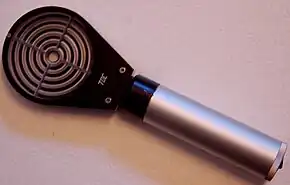| Keratoscope | |
|---|---|
 A keratoscope | |
| Purpose | assess shape of cornea |
A keratoscope, sometimes known as Placido's disk, is an ophthalmic instrument used to assess the shape of the anterior surface of the cornea. A series of concentric rings is projected onto the cornea and their reflection viewed by the examiner through a small hole in the centre of the disk. A regular-shaped cornea should show equally spaced symmetric reflections. If the patient is suffering from astigmatism or from a corneal dystrophy, the rings will be distorted.
A modern development of the concept is found in corneal topography, in which analysis of the reflected image is passed to a computer. The automated instrument can produce colour-coded contour maps of the eye's topography or even three-dimensional visualisations of its surface.[1]
References
- ↑ Lexikon der Optik : in zwei Bänden / 1 A bis L. Harry Paul. Heidelberg: Spektrum, Akad. Verl. 1999. ISBN 3-8274-0382-0. OCLC 165875417.
{{cite book}}: CS1 maint: others (link)
Wikimedia Commons has media related to Placidos keratoscope.
This article is issued from Wikipedia. The text is licensed under Creative Commons - Attribution - Sharealike. Additional terms may apply for the media files.